Spring is off to a warm and fast start here in Michigan. March was unseasonably warm and the past week or so has seen temperature 20 degrees above average or more. Needless to say this is pushing all of our landscape trees and shrubs. Forsythia and saucer magnolia are in full bloom, at least two weeks ahead of schedule. The warm weather also has us scrambling to get some research projects in the ground as well. Today I was working with members of my lab to install a trial to look at the relationship between fertilization in the nursery and subsequent of shade trees in the landscape. For the past two years we’ve grown Acer miyabei (‘State street’ maple) and ‘Harvest gold’ Linden trees in 25 gallon containers as part of a trial on controlled release fertilizer. Interestingly, in the nursery we saw a significant increase in chlorophyll index and foliar nitrogen with fertilization (no surprise) but no difference in caliper or height growth (somewhat of a surprise). This indicates that in the nursery, fertilization induced ‘luxury consumption’ or an uptake of nutrients beyond what the trees need to meet their growth requirement. This observation provided the opportunity for our current, follow-up study. In the forest nurseries there is a growing interest in the practice of ‘nutrient loading’ seedling trees before they are lifted. Forest nursery managers deliberately induce luxury consumption by fertilizing late in the season. At this time seedlings have set a hard bud and won’t grow but can take up additional nutrients. Numerous studies, particularly by Dr, Vic Timmer and his associates at the University of Toronto have shown that nutrient loaded seedlings will outgrow standard seedlings when out-planted on reforestation sites; even though the seedlings are the same size when transplanted. How does this apply to large-caliper shade trees? We don’t know. There are certainly some underlying commonalities that are intriguing. Nutrient loaded forest seedlings have an advantage when planted on tough sites where follow-up culture is minimal – basically the seedling has to get by initially with its own energy reserves and resources. Shade trees planted as street trees often face the same hardship; once planted they may receive little or no after-care beyond an initial watering. Could nutrient loading provide a better internal nutrient reserve and jump start the re-establishment process for street trees like it does for the smaller forest cousins? We should gain some insights this summer and next.
Friday investigation – April Fools!
I didn’t exactly cheat on this one…but it was a mean trick nevertheless.
This is a contorted cultivar of Larix (can’t remember the exact name and I’m out of town this week), hence the twisty needles. And indeed the tree is senescing. The newer growth (the second flush of the season) just wasn’t as prepared for fall as the older growth, which is yellowing naturally. So everything is just peachy with this tree.
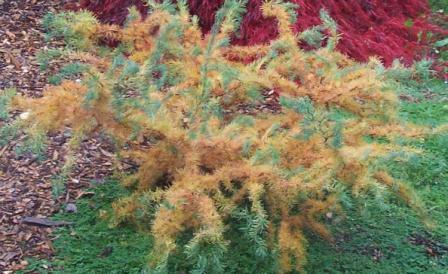
Just goes to show you how important it is to know all the details when doing distance diagnosis!
Friday investigation
Haber and Bosch
There are people who are fascinated by plants and people who are fascinated by the science of growing plants. While I love plants I must confess that I consider myself to reside more firmly in the latter group that the former. I do love to see the beautiful flowers on an apple tree in the spring, but I’m more fascinated by the nitrogen, phosphorus, potassium and other elements that the tree obtains from the soil. I like to contemplate the complex ecosystem that surrounds the tree, including the tree’s pests and the possible things that we can do to protect the tree from pests. I love to learn about insecticides, herbicides and fungicides, and I especially love to learn about alternatives like beneficial insects that may be used to control pests. Histories that cover fertilizers and pesticides are pleasure reading.
One of the most important things to ever happen to the world as we know it was the discovery of a process to take nitrogen from the air so that we could use it as a fertilizer. During the 1800s we discovered that applying nitrogen to our soils made plants grow really fast. Though this nitrogen could be supplied with manure we quickly learned that Peruvian Guano and Chilean nitrates had more concentrated nitrogen and so less needed to be added to fields to get bigger responses. Incidentally we could also use the nitrogen from these sources for bullets and bombs. Nitrogen is a cornerstone of most conventional explosives. Unfortunately these sources of nitrogen did have a drawback, they are not renewable resources. You may say — Hey, Guano’s renewable! — But you’d be stretching the truth. You see, guano is aged manure where the nitrogen has had a chance to become concentrated.
Anyway, by the time the 20th century rolled around we had used up much of the nitrogen available from South America and so we (and by we I mean the world in general) were hurting for nitrogen — particularly Germany. Germany had a feeling there was going to be a war and she needed a way to get nitrogen other than sailing all the way to Peru or Chile. So she put money into research. Pretty soon two researcher, Haber and Bosch, came up with a method to take nitrogen directly out of the air and make it into ammonia. Once present in ammonia it could then be used to make any number of other nitrogen based compounds, from fertilizers to bombs.
Coincidentally, Haber is also known as the father of chemical weapons. He led the German poison gas program and had a hand in developing such things as mustard gas. He was considered to be a patriot, but, born a Jew, the rise of Hitler wasn’t good for him and he was forced to leave in the early 1930s.
The story of Haber and Bosch is absolutely fascinating, not only because of the colorful characters, but because their discovery is, arguably, the most important factor in the increase of the worlds population over the last century. The best book that I know of on this topic is Enriching the Earth by Vacliv Smil. It’s a great book, but it does get a little technical. But my dad (he’s a chemist) showed me another book yesterday that is much more entertaining and readable than Smil’s book while retaining most of the pertinent science. It’s called The Alchemy of Air by Thomas Hager and, if your interested in fertilizers and the people who first developed them, then this is a must read.
Building healthy soils?
I love living in Seattle…but I’m getting increasingly impatient with the City’s “Building Healthy Soils” propaganda. For years I’ve questioned their recommendation to perpetually amend landscape soil with organic material to no avail. Let’s see what you all think of their “fact sheet” (which you can read here in its entirety).
“The best way to improve the soil is to add plenty of compost or other organic matter throughout the entire planting area before planting. Thoroughly mixing these materials deep into the soil helps provide water, air and nutrients to plant roots.”
Hmm. No mention of how to determine IF your soil needs improving; without a soil test, you have no idea what your baseline organic matter level is.
But perhaps this recommendation is only for vegetable gardens and annual beds? Nope. In the next paragraph, we’re told to “Mix in organic material before planting lawns, perennials, trees and shrubs.” We’re given helpful how-to instructions: “Use a shovel or digging fork to mix amendments into the top 6 to 12 inches of soil. It is important to amend the entire planting bed — not just small holes for each plant. When planting individual trees and shrubs in lawns or existing beds, amend an area at least 3 feet wide, or 3 to 5 times as wide as root balls over 12 inches in diameter. Rototill large areas where digging is impractical.”
Now we’ve got a serious problem. This practice is recommended for existing beds. Not only will extensive digging or rototilling destroy any soil structure you might have, it will also take out the roots of any desirable plants in the vicinity).
But let’s continue to ignore reality and go on to the annual recommendations for adding compost to soils.
“Clay soils: 16 cu. feet (.6 cu. yard) = 2 inch layer of compost for new gardens. Use 1 inch per year in established gardens.”
“Sandy soils: 24 cu. feet (.9 cu. yard) = 3 inch layer of compost for new gardens. Use 1 – 2 inches per year in established gardens.”
Is the compost used as a mulch in these existing gardens? No – the guidelines are prefaced with this instruction: “Gardens: mix compost to 10- to 12-inch depth.” (Can’t say this does much for promoting root growth either.)
This document shows a breathtaking lack of understanding of how landscapes function, especially over the long term. It takes an agricultural practice (annual organic amendment of crop fields) and misapplies it to permanent landscapes. It is devoid of the research which continues to show that improper soil amendment can cause serious problems such as soil subsidence, perched water tables, and nutrient overloads. This last point is especially important to anyone living near aquatic ecosystems, since excess nutrients always end up in the water.
Before you plant this year, find out what your soil needs before amending it. And remember that mulching is the natural (and sustainable) way to add organic matter to the soil.
Devious dandelions
As Austrian reader Johannes explained, the difference in dandelion flower height is due to herbivory – in this case from a lawnmower. Dandelions are quite adaptable to variable environments (the phenotypic plasticity Johannes also mentioned) and flower heights will increase or decrease depending on these variables. This ensures that the flowers will be accessible to pollinators, yet not decapitated by lawnmowers. It’s just one of the fascinating traits that make weeds successful!
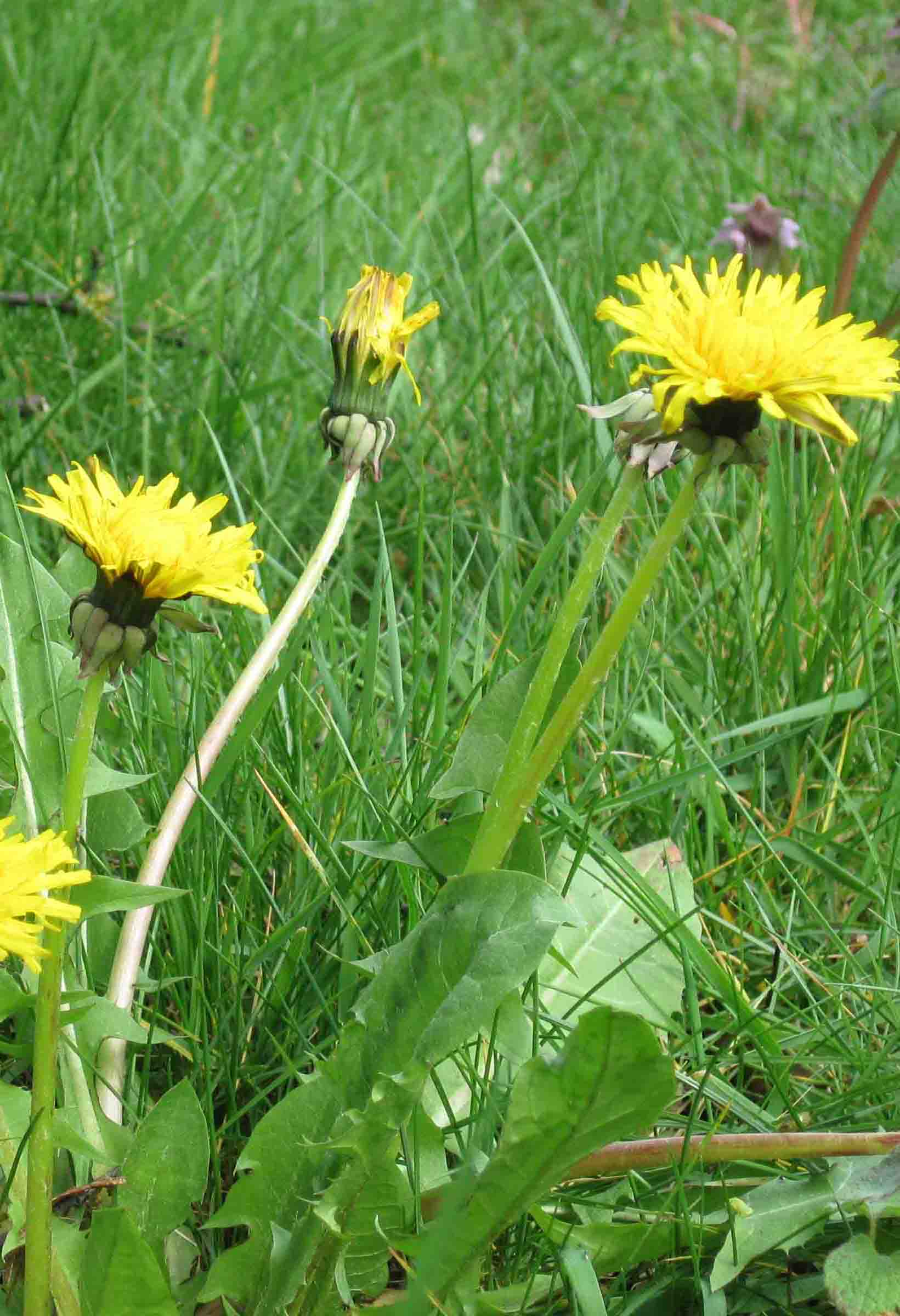

A Taraxacum teaser
It’s spring and the dandelions are happy to see you! I’ve taken photos of two groups of dandelions just footsteps away from one another. The populations are both in full sun, with similar types of soil and water availability. You’ll note that one group has very short flower stalks, while the second has longer stalks:
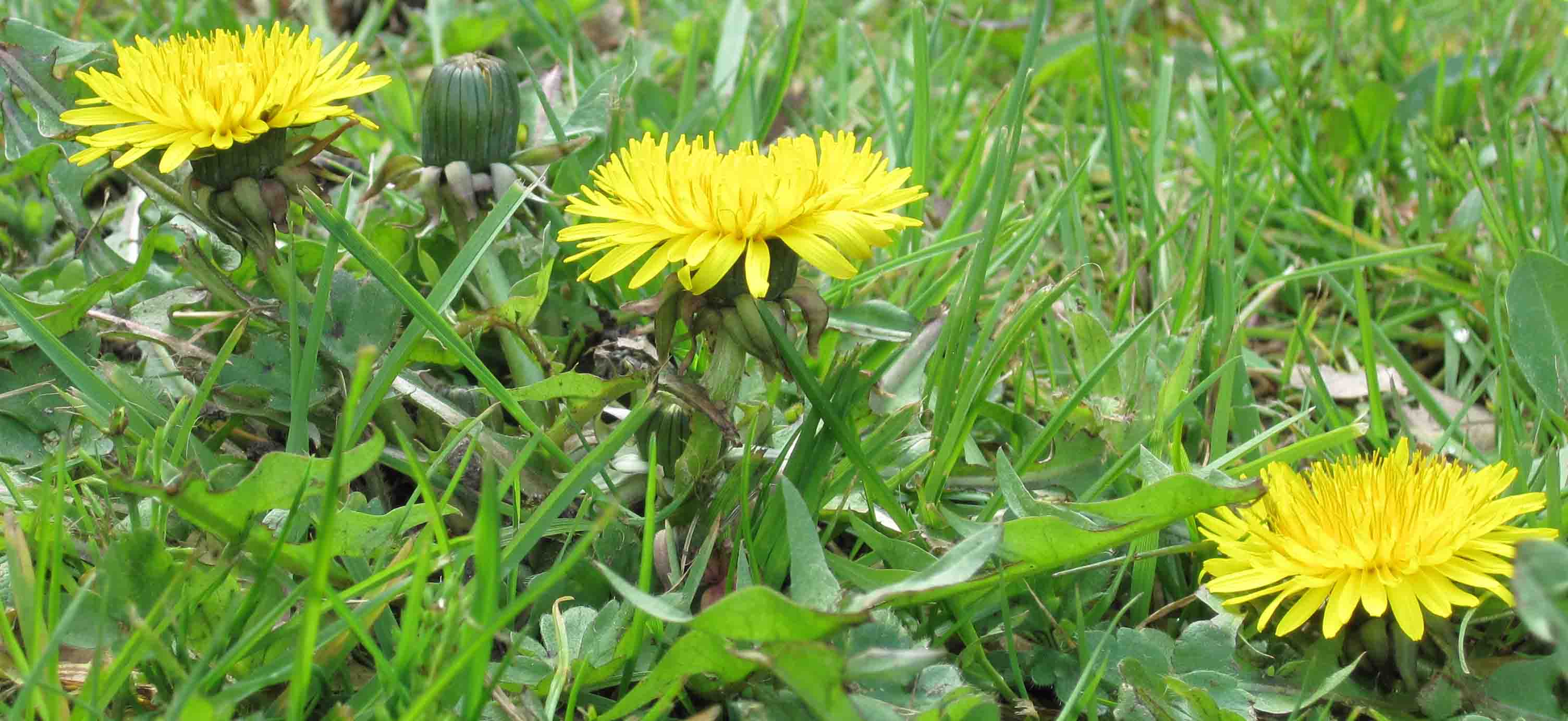

So what’s responsible for the difference in flower stalk length? And for extra credit, what’s the scientific term for the phenomenon?
If this isn’t something you’ve noticed before, you will from now on! Answers Monday!
Age
This time of year is very exciting for the students in my plant propagation class because now is when they all get to try grafting. In particular, they get to place buds from an apple tree onto a rootstock. There is nothing like placing a bud from one tree onto another to make a person feel as though they’re a horticulturist (NOT HorticulturALIST — that’s not a real word). Especially if that bud successfully grows on the plant where it was placed and produces a happy new tree — What a warm fuzzy feeling!
There are all kinds of things that a rootstock can offer to the bud placed on it. The rootstock can make the tree a dwarf, it can be resistant to certain diseases which the bud isn’t, it can even add some degree of cold hardiness. In return, the bud produces a cultivar that the grower wants such as ‘Honeycrisp’ apple. Additionally, the bud also offers an older tree. This probably doesn’t make sense at first, so think about it for a second or two. The bud that was grafted onto the rootstock came from a mature tree and so it may be more mature than the rootstock (which may have come from a seed — if the rootstock came from something besides a seed — like cuttings — then the rootstock may also be quite mature). Because the bud from which the top of the tree will grow is more mature than the base the tree will usually come into bearing sooner than if it were grown from seed.
Tree age is a funny thing. Though you wouldn’t expect it, the base of a tree is actually the youngest part of the tree physiologically while the older portion of the tree is at the top from which most new growth comes. The reason for this is that the bottom of the tree was laid down first as the tree first emerged from the soil and so the bud from which that growth came hadn’t had the chance to age much yet. After a few years of growing up the terminal bud developed more and more “age” and so the top of the tree is more mature. Confusing? It confuses me too — and I’m oversimplifying things quite a bit here. Making it even worse, no two tree species seem to age in exactly the same way.
Pardon If You’ve Seen This Before…
But it still makes me smile.
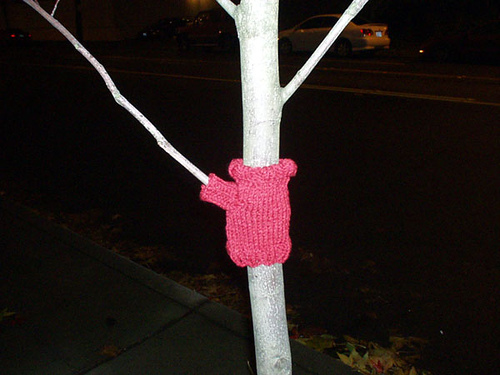
First published in December 2005, it’s still up at Red Shirt Knitting. Seattle yarn artist Erika’s story is posted, as is a chronological progression of photos and events since the original “fitting”.
She actually got some pretty funny tree questions/comments about potential girdling, the possibility of damage from moisture buildup (I like her response “What are YOUR sweaters made from…neoprene?”), etc.
Tortured urban tree examples abound: poorly planted, pitifully pruned, and other horrors. I think Miss Erika should get some kind of award for this public display of [tree] affection.
Organic or local?
I grew up on a small farm (30 or so acres) near Tacoma, Washington. We raised our own Herefords, I gathered eggs from my frizzle chickens, and we all enjoyed apples, plums and cherries from our fruit trees. Neither of my parents were farmers by profession, though my grandfather owned a dairy farm in Oregon. Eventually, my husband and I hope to move back to the family farm, if for no other reason than preserve it from the surrounding encroachment of houses.
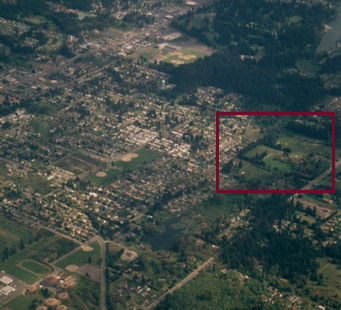
I’ve been thinking about things I might do for fun or profit on the farm. Home grown beef for sure. A veggie garden – finally – on some of the only native soil left in the area. We’ve got lots of options and the space to try them out.
Now back to the question in the title: organic or local? Our family property has been managed gently since we moved there in the late 1960’s. Nothing’s been added to the pasture soil other than what the animals deposited themselves. We’ve had the apple trees sprayed yearly (a requirement because of apple maggot), but this is a targeted application with little affect outside the trees. The cattle were never treated with hormones or other additives – they were about as free range as you can get.
I’ve heard from others that organic certification standards have become increasingly difficult to meet and some growers think they have become increasingly meaningless. On the other hand, locally-grown products are becoming more available.
Is it time for a new standard – locally grown, with some requirements (e.g. soil tests) to demonstrate safety?
